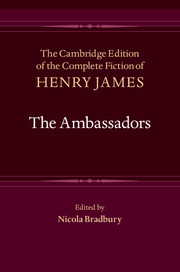Book contents
- Frontmatter
- Contents
- List of Illustrations
- Acknowledgments
- List of Abbreviations
- General Editors’ Preface
- General Chronology of James’s Life and Writings
- Introduction
- Textual Introduction
- Chronology of Composition and Production
- Bibliography
- The Ambassadors
- Glossary of Foreign Words and Phrases
- Notes
- Textual Variants
- Emendations
- Appendices
Textual Introduction
Published online by Cambridge University Press: 11 April 2021
- Frontmatter
- Contents
- List of Illustrations
- Acknowledgments
- List of Abbreviations
- General Editors’ Preface
- General Chronology of James’s Life and Writings
- Introduction
- Textual Introduction
- Chronology of Composition and Production
- Bibliography
- The Ambassadors
- Glossary of Foreign Words and Phrases
- Notes
- Textual Variants
- Emendations
- Appendices
Summary
What genetic criticism calls the avant-texte of The Ambassadors consists of two items unpublished in James's lifetime: the notebook record of the ‘germ’ of the novel, and the document called ‘Project of Novel by Henry James’ signed and dated 1 September 1900, which was sent to Harper’s. There are then four published texts: the periodical (here P) which came out in the North American Review in twelve parts from January to December 1903; the first English edition (here E) published by Methuen on 24 September 1903; the first American edition (here A) published by Harper and Brothers on 6 November 1903; then the revised text published in 1909 as volumes XXI and XXII of The Novels and Tales of Henry James, published by Scribner's and generally known as the New York Edition (here NYE). These four texts may be regarded as stages of composition. They are followed by the New York Edition ‘Preface’ that records and comments on this process as well as the novel itself.
For a detailed account of the genesis of the three early texts and the relations between them (P, E and A), see the Introduction, pp. XL–LV. In a textual situation so fraught, the selection for this edition of E as copy text is self-evidently open to debate. Although E predates the first American edition by six weeks, that was accidental, not the author's design. James prepared A from P with the intention of using proof copy from A for Methuen, his English publishers, and was only prevented from doing so by the slowness of Harper's in supplying material from America and mishaps in postal delivery. Moreover, a few years later, James chose A as the basis for his definitive New York Edition, only occasionally reverting to variants from E. Subsequent authorial preference, or at least convenience, apparently privileges A.
Nevertheless, there is at least as good a case for E. This is uncontroversially the first edition of the text published as a book, and it was prepared and seen through the press by James himself.
- Type
- Chapter
- Information
- The Ambassadors , pp. lxxxvii - xcPublisher: Cambridge University PressPrint publication year: 2015



